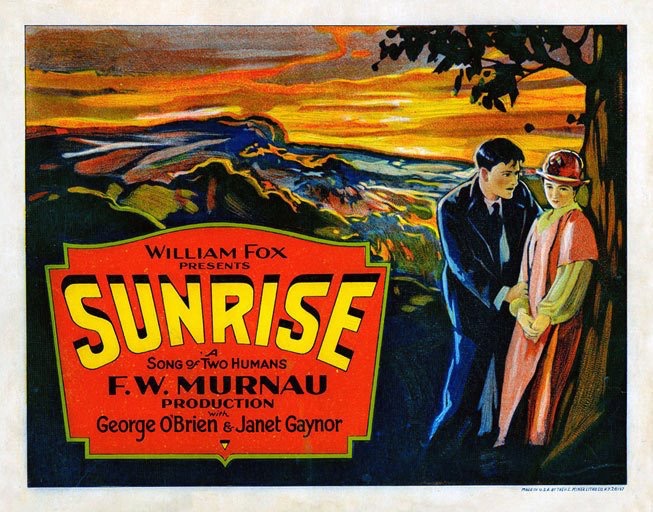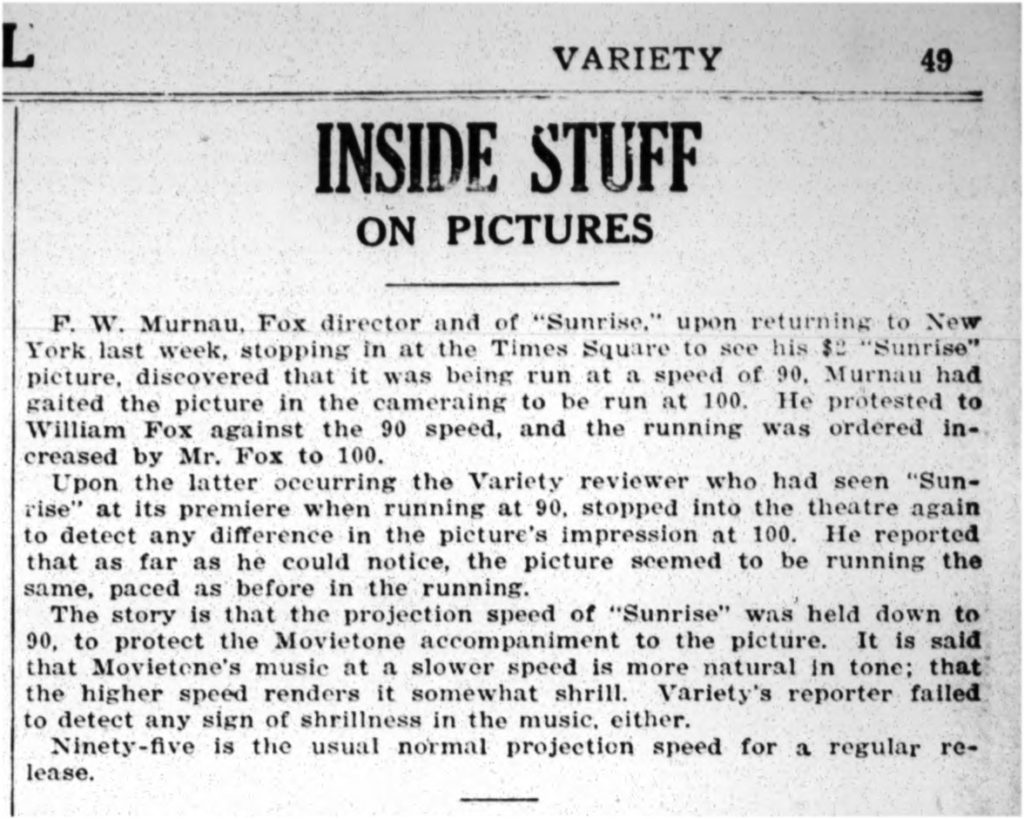Kevin Brownlow mailed me an item from “Variety” when I was beginning my research on silent film projection and filming speeds. What struck me is that it was yet another clue that silent era filmmakers had an expectation of what speed their films would be shown at when they were making their picture. The way taking speeds were chosen, and movement and physical pacing were directed and performed, were done deliberately to accommodate the speed-up.
It was a curious item that appeared in the paper in October of 1927 shortly after the movie Sunrise had opened. Apparently, F.W. Murnau had a problem with the speed his picture was being shown at. Projected at 24 frames per second, or 90 feet per minute was slower than what he’d expected or intended the film to being shown at.

Theaters that were wired for the Movietone or Vitaphone sound system showed the sound films at 24 fps. That was the speed decided upon for sound film. 24 fps or 90 ft/min was chosen because it was the average speed that films were being shown at in cinemas around the country, according to Western Electric engineer Stanley Watkins. Yes, by the mid 1920s, movies were being shown a bit faster than how you often see them today in some theaters.
Murnau’s expectation was that the film many people today consider one of the greatest pictures of the silent era was going to be shown in theaters at 100 feet per minute, or 27 fps. I’m posting the article from “Variety” below, so you can see the details.
The variable speed projectors in theaters I play at utilize this feature to run films slower than 24 fps, because films from the 1910s and in some cases early 1920s were originally shown that way. Running a drama or comedy short from 1919 at 20 or 21 fps makes a difference, and really helps the film read for an audience.
My research findings about films being projected faster than “sound speed” in the mid-to-late ‘20s prompted me to ask projectionists at MoMA and the Cinema Arts Centre et al, “could we run a film faster than 24?” Then answer, of course, was “yes”.
I had to find out. I had to know what Murnau wanted audiences to see in 1927. And so, a couple years ago, Dylan Skolnick and I programmed Murnau’s Sunrise at the monthly silent film series at the CAC, and made sure we were being sent a 35mm print and not a DCP. We ran the film at 27 fps at our show.
Maybe the audience didn’t notice the difference. Probably not.But there were a half dozen of us who chatted after the show, who’d seen the film a number of times and knew it. We saw a difference, and felt the film — genius as it is in the state we knew it in — played even better. The frenetic nature and energy of the city scenes landed better. Some of the scenes that were cranked faster and which had previously looked almost slow-motion — the daydream of Farrell pushing Ms. Gaynor out of the boat, for instance — blended in better with the rest of the film.
I’ve done a few more shows of the film at this speed, partially for my own interest. One show I did, at St. Francis College last year, was done with a DVD which we sped up by projecting the show via VLC media player. Tonight we’ll be running at 35mm print at the Ambler Theater, where the projectors were calibrated to run at precisely 100 feet per minute.
Films were being shown at faster rates than 24 fps in many cinemas in the late 1920s, and that’s how people were used to seeing them. I remember chatting with Kevin about this and about the Murnau article a few years ago, and he said “Oh, yes, the Germans were running films terribly fast”. I have a jpeg of the first page of the Huppertz score for Metropolis that indicates “28/29 fps”.
I recently found an article from 1927 that mentions an average speed of 105 ft/min (about 28 fps) in theaters in NYC. You can also read my post about finding the “smoking gun” that confirms people knew and expected the speed-up and compensated for it.
